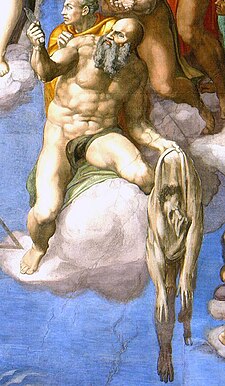
Flaying is a method of slow and painful execution in which skin is removed from the body. Generally, an attempt is made to keep the removed portion of skin intact.[ citation needed ]

Flaying is a method of slow and painful execution in which skin is removed from the body. Generally, an attempt is made to keep the removed portion of skin intact.[ citation needed ]
A dead animal may be flayed when preparing it to be used as human food, or for its hide or fur. This is more commonly called skinning.
Flaying of humans is used as a method of torture or execution, depending on how much of the skin is removed. This is often referred to as flaying alive. There are also records of people flayed after death, generally as a means of debasing the corpse of a prominent enemy or criminal, sometimes related to religious beliefs (e.g. to deny an afterlife); sometimes the skin is used, again for deterrence, esoteric/ritualistic purposes, etc. (e.g. scalping).[ citation needed ]
Dermatologist Ernst G. Jung notes that the typical causes of death due to flaying are shock, critical loss of blood or other body fluids, hypothermia, or infections, and that the actual death is estimated to occur from a few hours up to a few days after the flaying. [1] Hypothermia is possible, as skin provides natural insulation and is essential for maintaining body temperature.

Ernst G. Jung, in his Kleine Kulturgeschichte der Haut ("A short cultural history of the skin"), provides an essay in which he outlines the Neo-Assyrian tradition of flaying human beings. [2] Already from the times of Ashurnasirpal II (r. 883–859 BC), the practice is displayed and commemorated in both carvings and official royal edicts. The carvings show that the actual flaying process might begin at various places on the body, such as at the crus (lower leg), the thighs, or the buttocks.

In their royal edicts, the Neo-Assyrian kings seem to gloat over the terrible fate they imposed upon their captives, and that flaying seems, in particular, to be the fate meted out to rebel leaders. Jung provides some examples of this triumphant rhetoric. From Ashurnasirpal II:
I have made a pillar facing the city gate, and have flayed all the rebel leaders; I have clad the pillar in the flayed skins. I let the leaders of the conquered cities be flayed, and clad the city walls with their skins. The captives I have killed by the sword and flung on the dung heap.[ citation needed ]
The Rassam cylinder in the British Museum describes this:
Their corpses they hung on stakes, they took off their skins and covered the city wall with them. [3] [ better source needed ]
Searing or cutting the flesh from the body was sometimes used as part of the public execution of traitors in medieval Europe. A similar mode of execution was used as late as the early 18th century in France; one such episode is graphically recounted in the opening chapter of Michel Foucault's Discipline and Punish (1979).
In 1303, the treasury of Westminster Abbey was robbed while holding a large sum of money belonging to King Edward I. After the arrest and interrogation of 48 monks, three of them, including the subprior and sacrist, were found guilty of the robbery and flayed. Their skin was attached to three doors as a warning against robbers of church and state. [4] At St Michael & All Angels' Church in Copford in Essex, England, it is claimed that human skin was found attached to an old door, though evidence seems elusive. [5]
In Chinese history, Sun Hao, Fu Sheng and Gao Heng were known for removing skin from people's faces. [6] The Hongwu Emperor flayed many servants, officials and rebels. [7] [8] Hai Rui suggested that his emperor flay corrupt officials. The Zhengde Emperor flayed six rebels, [9] and Zhang Xianzhong also flayed many people. [10] Lu Xun said the Ming dynasty was begun and ended by flaying. [11]

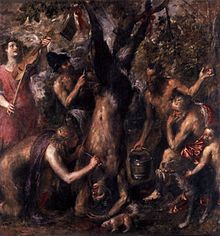
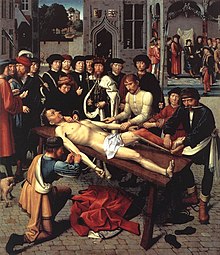
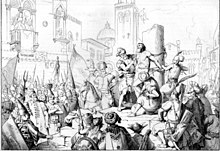
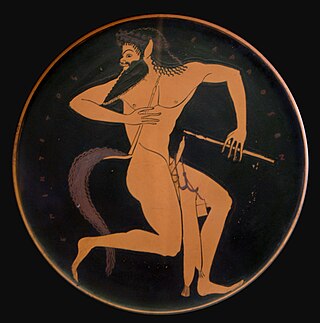
In Greek mythology, a satyr, also known as a silenus or silenos, and selini (plural), is a male nature spirit with ears and a tail resembling those of a horse, as well as a permanent, exaggerated erection. Early artistic representations sometimes include horse-like legs, but, by the sixth century BC, they were more often represented with human legs. Comically hideous, they have mane-like hair, bestial faces, and snub noses and they always are shown naked. Satyrs were characterized by their ribaldry and were known as lovers of wine, music, dancing, and women. They were companions of the god Dionysus and were believed to inhabit remote locales, such as woodlands, mountains, and pastures. They often attempted to seduce or rape nymphs and mortal women alike, usually with little success. They are sometimes shown masturbating or engaging in bestiality.
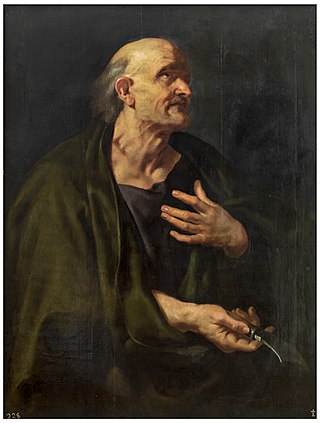
Bartholomew was one of the twelve apostles of Jesus according to the New Testament. Most scholars today identify Bartholomew as Nathanael or Nathaniel, who appears in the Gospel of John.

Edward Theodore Gein, also known as the Butcher of Plainfield or the Plainfield Ghoul, was an American murderer, suspected serial killer and body snatcher. Gein's crimes, committed around his hometown of Plainfield, Wisconsin, gathered widespread notoriety in 1957 after authorities discovered that he had exhumed corpses from local graveyards and fashioned keepsakes from their bones and skin. He also confessed to killing two women: tavern owner Mary Hogan in 1954, and hardware store owner Bernice Worden in 1957.

In Greek mythology, the satyr Marsyas is a central figure in two stories involving music: in one, he picked up the double oboe (aulos) that had been abandoned by Athena and played it; in the other, he challenged Apollo to a contest of music and lost his hide and life. In antiquity, literary sources often emphasize the hubris of Marsyas and the justice of his punishment.
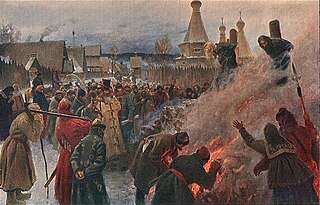
Death by burning is an execution, murder, or suicide method involving combustion or exposure to extreme heat. It has a long history as a form of public capital punishment, and many societies have employed it as a punishment for and warning against crimes such as treason, heresy, and witchcraft. The best-known execution of this type is burning at the stake, where the condemned is bound to a large wooden stake and a fire lit beneath.

Impalement, as a method of torture and execution, is the penetration of a human by an object such as a stake, pole, spear, or hook, often by the complete or partial perforation of the torso. It was particularly used in response to "crimes against the state" and regarded across a number of cultures as a very harsh form of capital punishment and recorded in myth and art. Impalement was also used during times of war to suppress rebellions, punish traitors or collaborators, and punish breaches of military discipline.

Execution by elephant was a method of capital punishment in South and Southeast Asia, particularly in India, where Asian elephants were used to crush, dismember, or torture captives during public executions. The animals were trained to kill victims immediately or to torture them slowly over a prolonged period. Most commonly employed by royalty, the elephants were used to signify both the ruler's power of life and death over his subjects and his ability to control wild animals.

Đorđe Petrović, better known by the sobriquet Karađorđe, was a Serbian revolutionary who led the struggle for his country's independence from the Ottoman Empire during the First Serbian Uprising of 1804–1813.
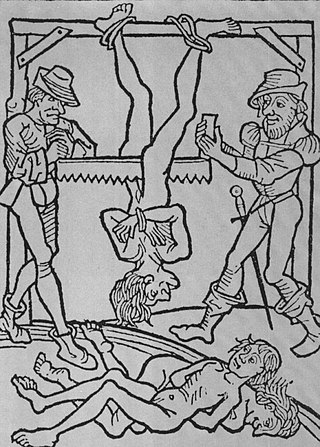
Death by sawing is the act of sawing or cutting a living person in half, either sagittally, or transversely.

Ashur-nasir-pal II was king of Assyria from 883 to 859 BCE. Ashurnasirpal II succeeded his father, Tukulti-Ninurta II. His son and successor was Shalmaneser III and his queen was Mullissu-mukannišat-Ninua.

Dismemberment is the act of completely disconnecting and or removing the limbs from a living or dead being. It has been practiced upon human beings as a form of capital punishment, especially in connection with regicide, but can occur as a result of a traumatic accident, or in connection with murder, suicide, or cannibalism. As opposed to surgical amputation of limbs, dismemberment is often fatal. In criminology, a distinction is made between offensive dismemberment, in which dismemberment is the primary objective of the dismemberer, and defensive dismemberment, in which the motivation is to destroy evidence.
Scaphism, also known as the boats, is an alleged ancient Persian method of execution mentioned by Plutarch in his Life of Artaxerxes. It ostensibly entailed trapping the victim between two boats, feeding and covering them with milk and honey, and allowing them to fester and be devoured by insects and other vermin over time.
Death by boiling is a method of execution in which a person is killed by being immersed in a boiling liquid. While not as common as other methods of execution, boiling to death has been practiced in many parts of Europe and Asia. Due to the lengthy process, death by boiling is an extremely painful method of execution.
Celaenae (Celænæ) or Kelainai was an ancient city of Phrygia and capital of the Persian satrapy of Greater Phrygia, near the source of the Maeander River in what is today west central Turkey, and was situated on the great trade route to the East.
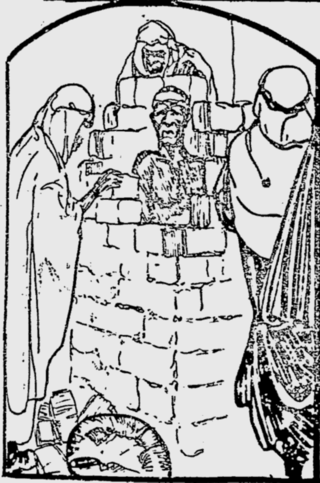
Immurement, also called immuration or live entombment, is a form of imprisonment, usually until death, in which someone is placed within an enclosed space without exits. This includes instances where people have been enclosed in extremely tight confinement, such as within a coffin. When used as a means of execution, the prisoner is simply left to die from starvation or dehydration. This form of execution is distinct from being buried alive, in which the victim typically dies of asphyxiation. By contrast, immurement has also occasionally been used as an early form of life imprisonment, in which cases the victims were regularly fed and given water. There have been a few cases in which people have survived for months or years after being walled up, as well as some people, such as anchorites, who have volunteered to be immured.

Ramsay Bolton, previously known as Ramsay Snow, is a fictional character in the A Song of Ice and Fire series of fantasy novels by American author George R. R. Martin, and its television adaptation Game of Thrones.

The Flaying of Marsyas is a painting by the Italian late Renaissance artist Titian, probably painted between about 1570 and his death in 1576, when in his eighties. It is now in the Archbishop's Palace in Kroměříž, Czech Republic and belongs to the Archbishopric of Olomouc. It is one of Titian's last works, and may be unfinished, although there is a partial signature on the stone in the foreground.

The Kurkh Monoliths are two Assyrian stelae of c. 852 BC & 879 BC that contain a description of the reigns of Ashurnasirpal II and his son Shalmaneser III. The Monoliths were discovered in 1861 by a British archaeologist John George Taylor, who was the British Consul-General stationed in the Ottoman Eyalet of Kurdistan, in a town called Kurkh, which is now known as Üçtepe, in the district of Bismil, in the province of Diyarbakir of Turkey. Both stelae were donated by Taylor to the British Museum in 1863.

Lingchi, translated variously as the slow process, the lingering death, or slow slicing, and also known as death by a thousand cuts, was a form of torture and execution used in China from roughly 900 CE up until the practice ended around the early 1900s. It was also used in Vietnam and Korea. In this form of execution, a knife was used to methodically remove portions of the body over an extended period of time, eventually resulting in death.

Saw Gerrera is a fictional character in the Star Wars franchise. He was originally introduced as a minor character in the animated series Star Wars: The Clone Wars, where he was voiced by Andrew Kishino. He was subsequently played by Forest Whitaker in the film Rogue One: A Star Wars Story, who went on to voice the character in the animated series Star Wars Rebels and the video game Star Wars Jedi: Fallen Order, and reprises the role in live-action in the television series Andor. Saw also appears in The Clone Wars spin-off Star Wars: The Bad Batch, with Kishino reprising his role.
His body was given over to the surgeons for dissection. He was skinned to supply such souvenirs as purses, his flesh made into grease, and his bones divided as trophies to be handed down as heirlooms. It is said that there still lives a Virginian who has a piece of his skin which was tanned, that another Virginian possesses one of his ears and that the skull graces the collection of a physician in the city of Norfolk.